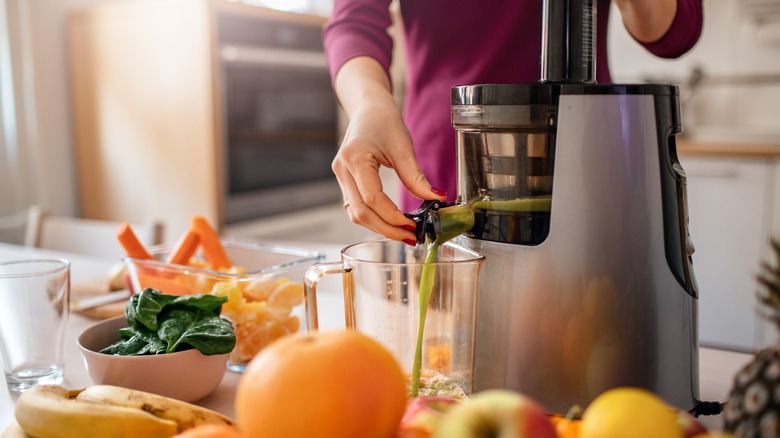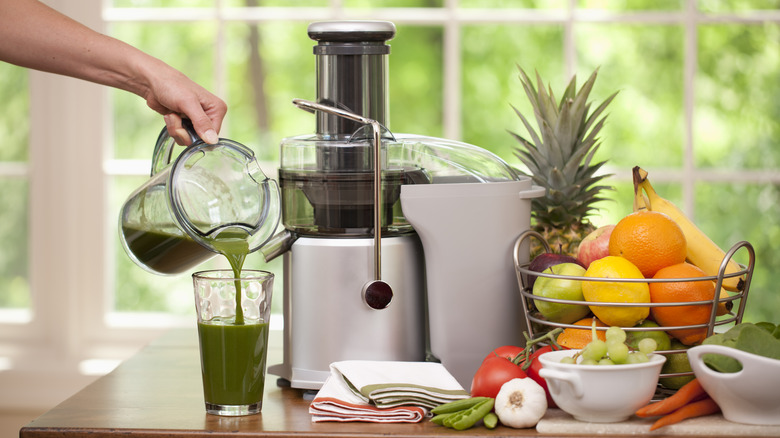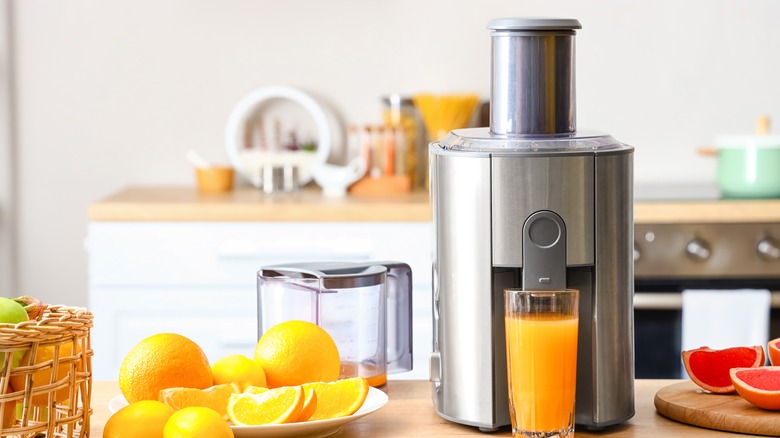How To Clean A Juicer And Avoid Endless Scrubbing
Juicers get a bad rap for being difficult to clean. Making your own vegetable and fruit juice from the comfort of your home is certainly a luxury, but keeping it pristine and unstained can be quite a task, especially if you let the appliance sit after you use it. No matter what kind of juicer you have, cleaning it immediately after you've extracted the literal fruits (or vegetables) of its labor is essential — and actually quite simple.
The best way to avoid never-ending scrubbing is to start by separating the juicer's components and discarding the pulp from the pulp container. Certain juicers contain dishwasher-safe parts, but even if you plan on skipping hand washing, you should rinse every removable juicer piece. Since bits of produce can get stuck in the blades, it's easy for these food particles to dry and decay even after being run through the dishwasher, leaving you with a funky-smelling juicer. Avoid this by removing the food beforehand and brushing any stubborn produce stuck in tiny blades or mesh filters. Fill a sink with warm, soapy water and let the juicer parts soak for a few minutes. For hand washing, use a toothbrush or dish brush to scrub food away, rinse with hot water, and let the parts air dry. To finish, give the base a quick wipe, ideally with a microfiber cloth, and put the juicer back together once all parts are dry.
Cleaning stained and stubborn juicer parts
Certain juicers contain parts made of plastic that are quick to stain and can trap smells. For juicer parts that need deeper cleaning, fill your sink with water and add a bit of lemon juice or vinegar. Let the parts soak overnight and wipe them down with a cloth in the morning. If the stains persist after a few hours of soaking, sprinkle them with baking soda and let them rest for another 30 minutes. Then, take a damp cloth, gently dip it into vinegar, and scrub. Rinse away once you're done and reassemble once everything is completely dry.
If you're using your juicer daily, a thorough weekly clean will keep the appliance running smoothly and save you from juice that contains bits of leftover fruit and vegetables from earlier in the week. Even if the juicer gets daily cleanings, spending a few extra minutes scraping away dried-on food particles you may have missed will prevent mold and bacteria build-up and keep your juice fresh and delicious.
A few tips for cleaner juicing at home
Keeping your juicer clean is the best way to ensure that it will last for years to come, but there are a few other tips to keep in mind when taking care of this beloved appliance. One tip for easier cleanup is to line the pulp container with a pulp bag for simple composting, disposal, or for setting aside to use in other recipes, like vegetable stock. The Breville Philippines TikTok account is a fan of this trick, giving it five stars for effectiveness.
@brevilleph Testing Food-Tock Hacks: Easy Juicer Clean Up #MasterEveryMoment #BrevillePh #juicingph #juicing #juicehack #kitchenhack #foodtok #juicingforhealth #juicer
Juicing foods with low water content will be hard on the machine, so be sure to stick to fruits and vegetables that are juicer friendly, like apples, citrus fruits, leafy greens, and beets (stay away from bananas and figs). It's wise to break produce down into smaller pieces so they easily fit through the chutes, and only use the plunger from the juicer to push items through the machine. Using a knife or any other object could permanently damage the appliance or cause injury, so stick with the tools the juicer arrives with.
Investing in a juicer is great for anyone who may be looking to save some cash after haunting the pricey juice bar down the street. Committing to cleaning it is a small price to pay for delicious fresh-squeezed juice at home.


